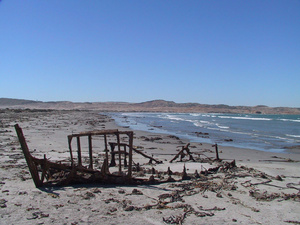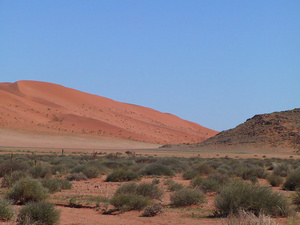Henk Dop: Namibia Trip Report 2005
Friday 22 April: Lüderitz and surroundings; 90 km
The wind allows us a fairly undisturbed breakfast, and we head for the Diamond Area Recreational Reserve just to the South of Lüderitz. Springboks dot the mudflats around the Lüderitz Bay, Flamingo's can be seen from afar. From windswept Diaz Point we look out at Halifax Island, and get to see Sealions and Jackass Penguin anyway, a fairly large colony among the deserted buildings from the days when guano was big business along this cold coast.
We now proceed along the many small bays and their picnic sites, the driving sometimes a bit challenging, and the landscape all too often scarred by idiots who cannot resist the off-road temptation. On this fragile soil, the traces remain for decades. Hardy short bushes cling to life between the rocks, the patterns of the wind in the sand and a myriad’s of insect and mammal tracks offer an amazing array of miniature landscapes. At the sandy beach of Grosse Bucht large flaps of Kelp lay glistening in the sun, also half-covering the carcass of a baby Sealion, and we excitedly find the fresh tracks of a Strandwolf (Brown Hyena)!
Around noon we head for Agate Beach to the North of Lüderitz, where these semi-precious stones are said to be easily picked up - or at least try to. The track as indicated on the map, and also signposted, ends at a rubbish dump with the smell of something long dead. We try an alternative, but end up in equally shabby surroundings that would be almost ideal for 'skelms' to try their luck.
After lunch at camp we go shopping at the local Spar, fill up the car's jerrycan, and decide that 'Legends' looks like a nice restaurant and a perfect alternative to another windy dinner. Marike and I do some more birding, and I finally manage to find the single secluded spot on all of Shark Island from where the sunset is a true delight. Both the Kudu fillet and the Ostrich steak at 'Legends' are superb and the service most friendly. By the time we leave towards 2100, the town seems devoid of any life. Back at camp we decide to have a beer in the field kitchen, causing us to scare the living daylights out of a security guard who had decided to take a nap on the kitchen sink. Leaving him in peace, we relocate to the laundry room.
Saturday 23 April: Lüderitz, Namib Naukluft Park, Sesriem campsite; 439 km
We leave Shark Island at 0730 and drive through a still almost deserted Lüderitz. The first stretch back along the B4 is almost straight into the sun, but then after Aus we turn left on the C13 and have the sun to our right. Marike and I know the C13 from 2001, it offers some of the most amazing views of all of Namibia. Fortunately, the road is now freshly scraped (die pad is vars geskraap), quite a difference from the agonising corrugation of last time.
The light is still fresh, and we make numerous photo stops. The sheer distance that one can oversee around here baffles the mind, it must be at least 20 km. Around 1000 we turn left again on the D707, a road not travelled before, and equally stunning as the C13. The Tirasberge are now on our right, the red dunes of the Namib on our left. We see twin bicycle tracks, must be those Swiss, and by the swaying of the tracks from left to right it can be seen that they must be having a hard time. Still, when we finally do pass them, they indicate that they're fine and don't need any water.
A few minutes later, just after 1100, we see a Volkswagen Golf lying on its side to the right of the road, and from the looks of it, it's a recent crash, obviously overturned as many cars do on these fine, yet treacherous gravel roads. Then, some kilometres further on, do we see another pair of cyclists in the distance? No, pedestrians this time. Two young women, who start to wave at us frantically, and turn out to be the occupants of the Golf. We pull over and are greeted as their saviours.
Maria from the UK and Rebecca from Norway, both in their early twenties, had teamed up in SA during their world travels and decided to rent a car for a trip to Namibia. Wholly inexperienced, and without having received any warning from the rental agency, they were prime candidates for just this type of accident: thinking that the excellent Namibian gravel roads could be driven on as it they were tarmac roads, they had managed to overturn the car within their first 100 km of gravel and before they even knew what could possibly be going wrong. With amazing good luck, a few seat-belt bruises was all they had suffered.
We cram their stuff into the car, tie a back-pack onto the roof, and offer to take them to Sesriem from where they can phone the rental agency. This is fine with them, they don't need to return to the wreck for the rest of their stuff, so we continue and hear more of their story. The accident happened around six last night, while they were hoping to still make it all the way to Sesriem. They had spent the night with the car, and when no cars were passing by in the early morning, they had made an inventory of their stuff and had decided to start walking with their supply of water and what they thought was a wise selection of stuff (in fact, it was pretty stupid).
I decide be gentle with them and not hammer home the compilation of ill-preparedness, bad judgement, stupid mistakes and wrong decisions they have displayed, but it does start to dawn on them that they had indeed come very close to being reduced to a mere statistic, one of the dozen or so foreigners who manage to kill themselves on the Namibian gravel each year. And on top of that, they make the next stupid mistake when they offer us 'all the beer we can drink' once we get to Sesriem, thus potentially adding bankruptcy to their predicament!
We enjoy the rest of the D707, the girls listening to Maarten's selection from his I-pod as well as our explanations of the landscape. We turn left on the C27, and get to familiar turf at Wereldsend ('the end of the world'). It's now past midday, and even though the light is turning bluish and hazy, the Namibrand views with the Nubib Berge to our right are stunning. Then, on a stretch of open plain, there are suddenly large numbers of Springbok around, Zebra's in the distance, scattered groups of Ostriches, and numerous Oryx off to our right. Sesriem campsite is reached at 1600, we fill up and I'm alerted to the obvious low pressure of the right rear tyre. Well, we could have lost some air on a few bad bumps, so I first have the air topped up. At the office, I offer to let the girls share our campsite, as it had also not dawned on them that reservations are essential at Sesriem. We insist that they dine with us, also giving Marike a better chance to observe the girls for any signs of hidden trauma.
At our campsite, situated at the outer edge and thus one of the camp's best, Maarten hears that the rear tyre is definitely hissing, so I head back to the fuel station to have it fixed. Two young men quickly and efficiently patch up the tyre, they amaze me with their knowledge of cars (somehow, the V6 manages to get a lot of people talking about really good cars), and are also simply delightful company. They cajole each other, one saying to the other 'I'll lift this wheel back on, I'm a Damara - only Damara are strong enough to do this'. And indeed, to have grown up and survived in this environment, you must be pretty strong.
We prepare an elaborate potjiekos, with meatballs, vegetables, dried fruits and rice, to the delight of our guests. To their almost visible relief, we spare them from the full brunt of the consequences of their promise of unlimited beer. Jackals are scurrying about on the plains outside camp, but then a pair of Cape Foxes also appears, quite oblivious to the Maglite, and let us have excellent looks at them from no more than a few meters away. OK, so they may be in part camp animals, but who cares at such a moment?


